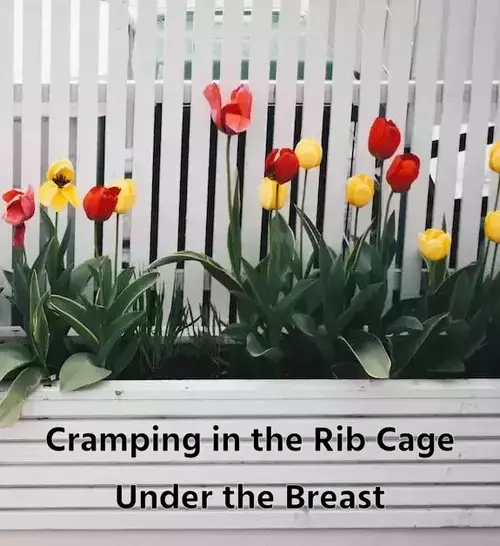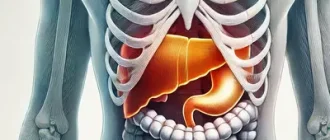Cramping in the rib cage under the breast can be an alarming and distressing sensation, often leading to concern about potential underlying health issues. This discomfort may result from various causes, ranging from minor muscle strains to more severe conditions such as costochondritis, pericarditis, or even heart attacks.
Understanding the potential causes of such cramps and seeking timely medical assessment is essential for receiving prompt treatment and ensuring overall wellbeing. This article will provide an overview of the common reasons for cramping in the rib cage under the breast and discuss appropriate management strategies, emphasizing the importance of relying on professional medical advice for accurate diagnosis and treatment.
Causes of Cramping in Rib Cage Under Breast
Cramping in the rib cage under the breast can occur due to various reasons, ranging from minor to severe conditions. One common cause is costochondritis, an inflammation of the cartilage connecting a rib to the breastbone.
Typically, costochondritis manifests as sharp, aching, or pressure-like pain on the left side of the breastbone and may radiate to the arms and shoulders. Other potential causes include heartburn, muscle strain, or injury to the chest wall.
In some cases, cramping in this area could indicate a more serious issue such as a heart attack or pericarditis, an inflammation of the membrane surrounding the heart.
It is crucial to consult with a healthcare professional for an accurate diagnosis and appropriate treatment plan tailored to the underlying cause of the discomfort.
Digestive Conditions That Can Cause Cramping
Occasionally, individuals may experience cramping in their rib cage under the breast due to various digestive conditions. Gastroesophageal reflux disease (GERD) and gastritis are two common factors contributing to this discomfort.
GERD occurs when stomach acid flows back into the esophagus, causing heartburn and potential cramping beneath the breast area. Gastritis, on the other hand, refers to inflammation of the stomach lining, often resulting in sharp or burning pain under the left breast. Both conditions can be accompanied by other symptoms such as bloating, nausea, and vomiting.
Proper diagnosis and treatment from a healthcare professional can help alleviate this pain and improve overall digestive health.
Heart and Lung Conditions That Can Cause Cramping
Several heart and lung conditions can cause cramping in the rib cage under the breast. Angina, a result of reduced blood flow to the heart, can cause chest pain and cramping.
A similar sensation may occur due to a heart attack, where persistent chest discomfort or pressure can be accompanied by pain radiating to the shoulders and arms.
Additionally, lung-related issues such as pleurisy, characterized by inflammation in the lining of the lungs, can cause sharp pain and cramping in the chest that worsens with deep breaths or coughing.
These conditions require urgent medical attention and appropriate treatment to prevent further complications.
Injury and Strain as a Cause of Cramping
Cramping in the rib cage under the breast may result from an injury or strain involving the ribs, surrounding muscles, or ligaments. This can occur due to accidents, falls, or overexertion during physical activities.
When these structures are damaged or inflamed, they may cause discomfort and cramping in the affected area.
Rib fractures, intercostal muscle strains, and costochondritis (an inflammation of the cartilage connecting the ribs to the breastbone) are common examples of injuries that can lead to cramping under the breast.
Proper rest, pain management, and appropriate medical intervention are crucial in addressing the cause and alleviating the associated pain.
Diagnosis
Diagnosing cramping in the rib cage under the breast typically begins with a thorough medical examination by a healthcare professional.
During the examination, the doctor will assess the patient’s symptoms and gather information about the onset, duration, location, and severity of the pain. Additionally, the doctor may inquire about any potential triggers or exacerbating factors, such as physical activity, deep breathing, or coughing.
Based on this information, the healthcare professional may recommend further tests such as X-rays, blood tests, or imaging studies to rule out or confirm potential causes, such as costochondritis, heart conditions, or gastrointestinal issues.
Timely and accurate diagnosis is crucial in determining the appropriate treatment plan for the patient.
Treatment Options for Cramping in Rib Cage Under Breast
- Over-the-counter pain relievers: Mild to moderate pain caused by conditions such as costochondritis can be managed with pain relief medications like ibuprofen and acetaminophen. Always follow the recommended dosage and consult a doctor if pain persists.
- Heat or cold therapy: Applying heat or cold packs can help relieve muscle cramps, strains, and inflammation in the affected area. Use a heating pad or an ice pack, depending on personal preference, applying for 15-20 minutes a few times a day.
- Rest: Taking a break from activities that worsen the pain, such as strenuous workouts, can promote healing and alleviate discomfort.
- Gentle stretching and exercise: Engaging in low-impact activities like walking or stretching can help maintain flexibility and strength in the chest muscles.
- Anti-inflammatory medications: In cases of severe inflammation, such as acute pericarditis, a doctor may prescribe a corticosteroid, like prednisone, to alleviate symptoms.
- Treating underlying conditions: Persistent or severe pain under the breast could indicate a more serious issue, such as heart problems or gastritis. Seek immediate medical attention to diagnose and treat the underlying condition.
- Lifestyle changes: Adopting a healthy lifestyle, including a balanced diet, regular exercise, and stress management, can improve overall wellbeing and prevent future instances of cramping.
Home Remedies for Alleviating Cramping
If you’re experiencing cramping under your breasts, it’s important to explore the possible causes, as the pain could range from simple indigestion to a more serious condition. Here are some home remedies that may help alleviate cramping in the rib cage:
- Warm Compress: Applying a warm compress to the affected area may help relax the muscles and alleviate cramping pain.
- Over-the-counter pain relievers: Take a recommended dose of over-the-counter pain relievers like ibuprofen or acetaminophen to help reduce discomfort.
- Stretching: Gently stretching the muscles in the chest and rib cage area can help relieve muscle tension and cramps.
- Deep Breathing Exercises: Practicing deep breathing exercises may help reduce stress and muscle tension, potentially alleviating cramping pain.
Please note that these remedies are not a substitute for professional medical advice or treatment. If you’re experiencing severe or persistent cramping, or if you suspect heart-related issues, it’s essential to seek prompt medical attention.
When to Seek Medical Attention
It is essential to seek medical attention if you experience persistent or severe cramping in the rib cage under the breast.
Some warning signs that warrant immediate medical attention include shortness of breath, dizziness, chest pain radiating to the arm, jaw, or back, and a feeling of impending doom. These symptoms may be indicative of a heart attack, angina, or other serious medical conditions.
Additionally, it is crucial to consult a healthcare professional if the cramping is accompanied by a fever, unexplained weight loss, or if the pain worsens over time. Timely diagnosis and treatment can help prevent complications and ensure a better health outcome.
About the Author
Reyus Mammadli is the author of this health blog since 2008. With a background in medical and biotechnical devices, he has over 15 years of experience working with medical literature and expert guidelines from WHO, CDC, Mayo Clinic, and others. His goal is to present clear, accurate health information for everyday readers — not as a substitute for medical advice.







